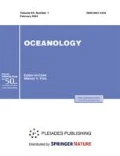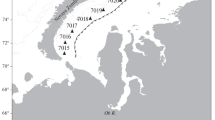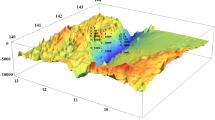Abstract
Picophytoplankton abundance, biomass, and chlorophyll a concentration as well as contribution of picoalgae to total chlorophyll a, and species composition of phototrophic picoeukaryotes (cells size less than 3 µm) were studied in Blagopoluchia Bay (Novaya Zemlya archipelago) and the northwestern part of the Kara Sea in September 2017. In the Bay, the highest picophytoplankton abundance and biomass were found in the surface layer and averaged 0.75 × 109 cell/m3 and 1.49 mg С/m3 respectively. In the northwestern part of the Kara Sea, the highest abundance and biomass of picophytoplankton were observed in the 8 m layer and were 2.29 × 109 cells/m3 and 2.76 mg С/m3 respectively. The contribution of picophytoplankton to total chlorophyll a concentration varied from 12 to 24% in the Bay and reached 46% in the Kara Sea. The Illumina sequencing of the V4 region of 18S rRNA gene revealed eight classes of phototrophic picoeukaryotes. Mamiellophyceae dominated in the number of reads. Arctic endemic (Micromonas polaris) and widespread (Bathycoccus prasinos) species were revealed in both studied areas.



Similar content being viewed by others
REFERENCES
A. B. Amelina, A. V. Drits, V. M. Sergeeva, et al., “Zooplankton in bays of the Novaya Zemlya Archipelago: composition, distribution, and role in phytoplankton grazing and biosedimentation,” Oceanology (Engl. Transl.) 58, 825–837 (2018).
T. A. Belevich, L. V. Ilyash, A. B. Demidov, and M. V. Flint, “Picophytoplankton distribution at the Ob River section and in the western part of the Kara Sea,” Oceanology (Engl. Transl.) 59, 871–880 (2019).
A. G. Zatsepin, P. O. Zavyalov, V. V. Kremenetskiy, et al., “The upper desalinated layer in the Kara Sea,” Oceanology (Engl. Transl.) 50, 657–667 (2010).
S. A. Mosharov, “Distribution of the primary production and chlorophyll a in the Kara Sea in September of 2007,” Oceanology (Engl. Transl.) 50, 884–892 (2010).
I. N. Sukhanova, M. V. Flint, V. M. Sergeeva, and V. V. Kremenetskiy, “Phytoplankton of the south-western part of the Kara Sea,” Oceanology (Engl. Transl.) 51, 978–992 (2011).
I. N. Sukhanova, M. V. Flint, E. I. Druzhkova, et al., “Phytoplankton in the northwestern Kara Sea,” Oceanology (Engl. Transl.) 55, 547–560 (2015).
I. N. Sukhanova, M. V. Flint, and V. M. Sergeeva, “Phytoplankton of the surface desalted lens of the Kara Sea,” Oceanology (Engl. Transl.) 52, 635–645 (2012).
N. S. R. Agawin, C. M. Duarte, and S. Agusti, “Nutrient and temperature control of the contribution of picoplankton to phytoplankton biomass and production,” Limnol. Oceanogr. 45 (8), 1891–1899 (2000).
E. J. Arar and G. B. Collins, Method 445.0 In Vitro Determination of Chlorophyll a and Pheophytin ain Marine and Freshwater Algae by Fluorescence, Revision 1.2 (US Environmental Protection Agency, Washington, DC, 1997).
S. Balzano, D. Marie, P. Gourvil, and D. Vaulot, “Composition of the summer photosynthetic pico and nanoplankton communities in the Beaufort Sea assessed by T-RFLP and sequences of the 18S rRNA gene from flow cytometry sorted samples,” ISME J. 6, 1480–1498 (2012).
T. A. Belevich, L. V. Ilyash, I. A. Milyutina, et al., “Metagenomic analyses of White Sea picoalgae: first data,” Biochemistry (Moscow) 80, 1514–1521 (2015).
T. A. Belevich, L. V. Ilyash, I. A. Milyutina, et al., “Phototrophic picoeukaryotes of Onega Bay, the White Sea: Abundance and species composition,” Moscow Univ. Biol. Sci. Bull. 72, 109–114 (2017).
T. A. Belevich, L. V. Ilyash, I. A. Milyutina, et al., “Metagenomics of Bolidophyceae in plankton and ice of the White Sea,” Biochemistry (Moscow) 82, 1917–1928 (2017).
B. C. Booth and R. A. Horner, “Microalgae on the Arctic Ocean section, 1994: species abundance and biomass,” Deep Sea Res., Part II 44, 1607–1622 (1997).
M. T. Cottrell and D. L. Kirchman, “Photoheterotrophic microbes in the arctic ocean in summer and winter,” Appl. Environ. Microbiol. 75 (15), 4958–4966 (2009).
A. B. Demidov, O. V. Kopelevich, S. A. Mosharov, S. V. Sheberstov, and S. V. Vazyulya, “Modeling Kara Sea phytoplankton primary production: development and skill assessment of regional algorithms,” J. Sea Res. 125, 1–17 (2017).
E. S. Egge, T. V. Johannessen, T. Andersen, et al., “Seasonal diversity and dynamics of haptophytes in the Skagerrak, Norway, explored by high-throughput sequencing,” Mol. Ecol. 24, 3026–3042 (2015).
H. P. Hansen and F. Koroleff, “Determination of nutrients,” in Methods of Seawater Analysis, Ed. by K. Grashoff, (Wiley, Chichester, 1999), pp. 149–228.
M. Ichinomiya and A. Kuwata, “Seasonal variation in abundance and species composition of the Parmales community in the Oyashio region, western North Pacific,” Aquat. Microb. Ecol. 75 (3), 207–223 (2015).
M. Ichinomiya, A. Lopes dos Santos, P. Gourvil, et al., “Diversity and oceanic distribution of the Parmales (Bolidophyceae), a picoplanktonic group closely related to diatoms,” ISME J. 10 (10), 2419–2434 (2016).
E. S. Kilias, E.-M. Noethig, C. Wolf, and K. Metfies, “Picoeukaryote plankton composition off West Spitsbergen at the entrance to the Arctic Ocean,” J. Eukaryotic Microbiol. 61 (6), 569–579 (2014).
E. Kilias, C. Wolf, E. M. Nothig, et al., “Protist distribution in the western Fram Strait in summer 2010 based on 454-pyrosequencing of 18S rDNA,” J. Phycol. 49 (5), 996–1010 (2013).
A. R. Kirkham, C. Lepère, L. E. Jardillier, et al., “A global perspective on marine photosynthetic picoeukaryote community structure,” ISME J. 7 (5), 922–936 (2013).
W. K. W. Li, E. C. Carmack, F. A. McLaughlin, et al., “Space-for-time substitution in predicting the state of picoplankton and nanoplankton in a changing Arctic Ocean,” J. Geophys. Res.: Oceans 118, 5750–5759 (2013).
C. Lovejoy, W. F. Vincent, S. Bonilla, et al., “Distribution, phylogeny, and growth of cold-adapted picoprasinophytes in arctic seas,” J. Phycol. 43 (1), 78–89 (2007).
M. Majaneva, J. M. Rintala, M. Piisila, et al., “Comparison of wintertime eukaryotic community from sea ice and open water in the Baltic Sea, based on sequencing of the 18S rRNA gene,” Polar Biol. 35 (6), 875–889 (2012).
M. Marquardt, A. Vader, E. I. Stubner, et al., “Strong seasonality of marine microbial eukaryotes in a high-Arctic fjord (Isfjorden, in West Spitsbergen, Norway),” Appl. Environ. Microbiol. 82 (6), 1868–1880 (2016).
F. A. McLaughlin and E. C. Carmack, “Deepening of the nutricline and chlorophyll maximum in the Canada Basin interior, 2003–2009,” Geophys. Res. Lett. 37, L24602 (2010). https://doi.org/10.1029/2010GL045459
S. Menden-Deuer and E. J. Lessard, “Carbon to volume relationships for dinoflagellates, diatoms, and other protist plankton,” Limnol. Oceanogr. 45, 569–579 (2000).
K. Metfies, W.-J. von Appen, E. Kilias, et al., “Biogeography and photosynthetic biomass of arctic marine picoeukaryotes during summer of the record sea ice minimum 2016,” PLoS One 11 (2), 1–20 (2016).
S. Y. Moon-van der Staay, R. De Wachter, and D. Vaulot, “Oceanic 18S rDNA sequences from picoplankton reveal unsuspected eukaryotic diversity,” Nature 409, 607–610 (2001).
P. F. Moreira-Turcq, G. Cauwet, and J. M. Martin, “Contribution of flow cytometry to estimate picoplankton biomass in estuarine systems,” Hydrobiologia 462 (1–3), 157–168 (2001).
F. Not, R. Massana, M. Latasa, D. Marie, et al., “Late summer community composition and abundance of photosynthetic picoeukaryotes in Norwegian and Barents Seas,” Limnol. Oceanogr. 50, 1677–1686 (2005).
W. Orsi, Y. C. Song, S. Hallam, and V. Edgcomb, “Effect of oxygen minimum zone formation on communities of marine protists,” ISME J. 6 (8), 1586–1601 (2012).
M. L. Paulsen, H. Doré, L. Garczarek, L. Seuthe, et al., “Synechococcus in the Atlantic gateway to the Arctic Ocean,” Front. Mar. Sci. 3 (191), 191–205 (2016).
B. J. Peterson, J. McClelland, R. Curry, et al., “Trajectory shifts in the Arctic and subarctic freshwater cycle,” Science 313, 1061–1066 (2006).
L. Polyak, R. B. Alley, J. T. Andrews, et al., “History of sea ice in the Arctic,” Q. Sci. Rev. 29, 1757–1778 (2010).
C. Quast, E. Pruesse, P. Yilmaz, et al., “The SILVA ribosomal RNA gene database project: improved data processing and web-based tools,” Nucleic Acids Res. 41 (1), D590–D596 (2013).
C. G. Ribeiro, M. D. Dominique, A. L. dos Santos, et al., “Estimating microbial populations by flow cytometry: comparison between instruments,” Limnol. Oceanogr: Methods. 14, 750–758 (2017).
P. D. Schloss, S. L. Westcott, T. Ryabin, et al., “Introducing mothur: open-source, platform-independent, community-supported software for describing and comparing microbial communities,” Appl. Environ. Microbiol. 75 (23), 7537–7541 (2009).
M. Simon, P. López-García, D. Moreira, and L. Jardillier, “New haptophyte lineages and multiple independent colonizations of freshwater ecosystems,” Environ. Microbiol. Rep. 5 (2), 322–332 (2013).
A. Stamatakis, “RAxML version 8: a tool for phylogenetic analysis and post-analysis of large phylogenies,” Bioinformatics 30, 1312–1313 (2014).
R. Terrado, K. Scarcella, M. Thaler, et al., “Small phytoplankton in Arctic seas: vulnerability to climate change,” Biodiversity 14 (1), 2–18 (2013).
M. Tragin and D. Vaulot, “Novel diversity within marine Mamiellophyceae (Chlorophyta) unveiled by metabarcoding,” Sci. Rep. 9, 5190 (2019). https://doi.org/10.1038/s41598-019-41680-6
G. Tremblay, C. Belzile, M. Gosselin, et al., “Late summer phytoplankton distribution along a 3500 km transect in Canadian Arctic waters: strong numerical dominance by picoeukaryotes,” Aquat. Microb. Ecol. 54, 55–70 (2009).
D. Vaulot, W. Eikrem, M. Viprey, and H. Moreau, “The diversity of small eukaryotic phytoplankton (≤ 3 mm) in marine ecosystems,” FEMS Microb. Rev. 32 (5), 795–820 (2008).
P. G. Verity, C. Y. Robertson, C. R. Tronzo, et al., “Relationship between cell volume and the carbon and nitrogen content of marine photosynthetic nanoplankton,” Limnol. Oceanogr. 37, 1434–1446 (1992).
M. Waleron, K. Waleron, W. F. Vincent, and A. Wilmotte, “Allochthonous inputs of riverine picocyanobacteria to coastal waters in the Arctic Ocean,” FEMS Microbiol. Ecol. 59, 356–365 (2007).
A. Z. Worden, “Picoeukaryote diversity in coastal waters of the Pacific Ocean,” Aquat. Microb. Ecol. 43, 165–175 (2006).
W. Wu, B. Huang, Y. Liao, and P. Sun, “Picoeukaryotic diversity and distribution in the subtropical-tropical South China Sea,” FEMS Microbiol. Ecol. 89 (3), 563–579 (2014).
F. Zhang, J. He, L. Lin, and H. Jin, “Dominance of picophytoplankton in the newly open surface water of the central Arctic Ocean,” Polar Biol. 38 (7), 1081–1089 (2015).
F. Zhu, R. Massana, F. Not, et al., “Mapping of picoeukaryotes in marine ecosystems with quantitative PCR of the 18S rRNA gene,” FEMS Microbiol. Ecol. 52 (1), 79–92 (2005).
ACKNOWLEDGMENTS
The authors thank P.N. Makkaveev and S.A. Shchuka for supplying hydrophysical and hydrochemical data.
Funding
This work was performed as part of the State Tasks of Moscow State University, part 2 (topic no. AAAA-A16-116021660052–0 and AAAA-A17-117120540067-0); the expedition was supported by the Russian Foundation for Basic Research (project no. 18–05–60069 Arctic); sample processing and data analysis, by the Russian Foundation for Basic Research (project no. 19–05–00026a).
Author information
Authors and Affiliations
Corresponding author
Ethics declarations
The authors declare that they have no conflict of interest. This article does not contain any studies involving animals or human participants performed by any of the authors.
Additional information
Translated by V. Mittova
Rights and permissions
About this article
Cite this article
Belevich, T.A., Milyutina, I.A., Troitsky, A.V. et al. Picophytoplankton in Blagopoluchia Bay (Novaya Zemlya Archipelago) and Adjacent Part of the Kara Sea. Oceanology 60, 473–482 (2020). https://doi.org/10.1134/S0001437020040037
Received:
Revised:
Accepted:
Published:
Issue Date:
DOI: https://doi.org/10.1134/S0001437020040037




